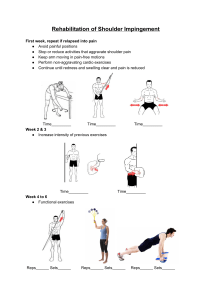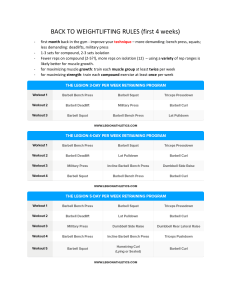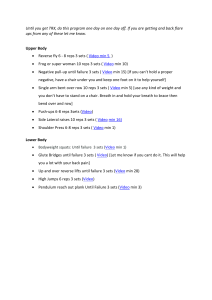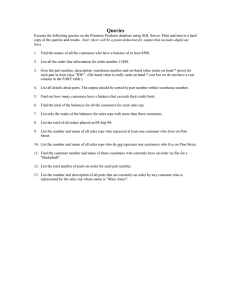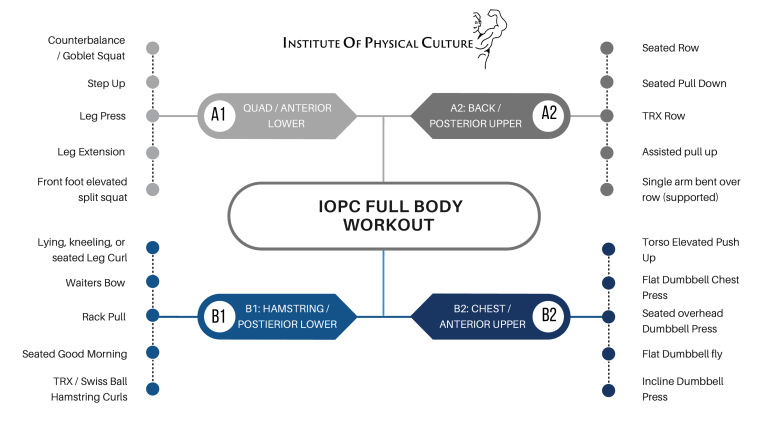
Counterbalance / Goblet Squat Seated Row Step Up Leg Press Seated Pull Down A1 QUAD / ANTERIOR LOWER A2: BACK / POSTERIOR UPPER A2 Leg Extension TRX Row Assisted pull up Front foot elevated split squat Single arm bent over row (supported) IOPC FULL BODY WORKOUT Lying, kneeling, or seated Leg Curl Torso Elevated Push Up Waiters Bow Flat Dumbbell Chest Press Rack Pull B1 B1: HAMSTRING / POSTIERIOR LOWER B2: CHEST / ANTERIOR UPPER B2 Seated overhead Dumbbell Press Seated Good Morning Flat Dumbbell fly TRX / Swiss Ball Hamstring Curls Incline Dumbbell Press How to Structure your workout A & B SUPERSETS HOW MANY REPS? A super set is where you complete a set of one exercise, then move directly into completing a set of another exercise. A1 & A2 exercises are superset together, and the B1 & B2 exercises are superset together. As an example, if you were doing 3 sets of 15 reps your workout would look like this: 15 reps of A1 15 reps of A2 15 reps of A1 This is the considered the 'A series', 15 reps of A2 15 reps of A1 15 reps of A2 15 reps of B1 15 reps of B2 15 reps of B1 This is the considered the 'B series', 15 reps of B2 If you are a beginner or getting back into the gym after some time off, we recommend starting off with a higher rep range along the lines of 15-20 reps. There are a few reasons for this: 15 reps of B1 15 reps of B2 } } Higher reps allow for more practice of the movement pattern The higher the reps, the lighter the weight which is safer when learning or easing back into things Lower rep strength training needs to be earned, as the lower the reps the heavier weight, the more important technique becomes and the more skill is required. Start with 15-20 reps for a 4 week block. As you advance the rep ranges can lessen to 12-15, then 10-12, then 8-10. (Note, this advice is for general training. If you are working towards something specific, this information may not apply - different rep ranges elicit different adaptations) How to Structure your workout HOW FAST SHOULD I DO THE EXERCISE? It is very important when doing any type of weight lifting or resistance training, that you have complete control over the entire movement. You should never let the weight control the movement, the movement should control the weight. A good rule of thumb, especially when starting out, is to make sure when you lower the weight, or do the lowering part of the movement, that you do it slowly and controlled. Take approximately 3 seconds to perform this part of the exercise. WHICH EXERCISES DO I DO? Pick one exercise from each list. You will only do one exercise for each series (A1, A2, B1, B2). HOW MANY SETS SHOULD I DO? We recommend starting with 3 sets, of 12-15 or 15-20 reps. Use this rep & set scheme for a 3-4 week block, making sure you use progressive overload throughout this time. Progressive overload is where you increase the workload every time you workout whether by adding weight, adding reps, or reducing rest periods. After an initial 3-4 week block, you can increase the weights used, decrease the reps to 10-12 or 12-15, and increase the sets to 4. WHAT WEIGHT DO I USE? Use a weight where you can successfully complete the amount of reps, but the last 1-3 reps need to be difficult (while keeping good form). If the rep range is 12-15, and you can't get 12 reps, the weight is too heavy and you need to go lighter. If you get 15 reps and could do more, the weight is too light and you need to go heavier. How to Structure your workout HOW MUCH REST DO I TAKE? CAN I ADD MORE TO THE WORKOUT? With a higher rep range and lighter the weight, you can get away with a shorter rest period. Once you have completed the A & B series, we do suggest finishing off with: With the structure of this workout (superset, full body, higher reps), we would suggest around a 1 minute rest between sets. Take up to 2 minutes if you need. WHAT IF I AM ADVANCED? If you are an intermediate to advanced lifter, chances are you will have your own program that you are following. If you do not, and you want to follow a template like this, you can adjust the rep ranges to work within your desired strength outcome, and select exercises that are more advanced/technical. Such as Squats, Deadlifts, pull ups, barbell bench press etc. We would also suggest adding a C & D series of supplementary exercises. A core exercise; A glute exercise; and/or Some aerobic conditioning. The following page will have some example exercises for you to choose from. If you have any specific areas you would like to bring up (e.g. arms, calves, shoulders) you could add in a C series of these exercises. WHAT IF I NEED HELP? An IOPC coach can run you through how to perform these exercises in your induction. If you feel you're still stuggling and want some further guidance, we recommend attending a Learn to Lift class, or booking in for some PT sessions. Hip Thrust / Glute Bridge McGill Side Plank Belly Breath Plank Hollow Hold CORE GLUTES Banded Side Step 45 Degree Back Extension Seated Good Morning V-Up ADD ONS Echo Bike Reverse Tabata Echo Bike Tabata LISS Aerobic Intervals Echo Bike Sprints AEROBIC CONDITIONING ANAEROBIC CONDITIONING Modified Strongman Heavy Bag Work 500m row
